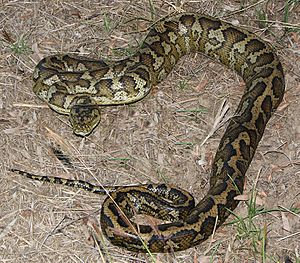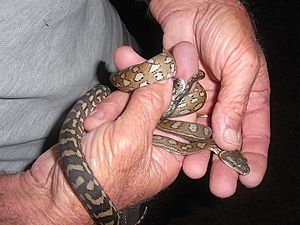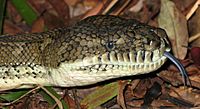Coastal carpet python facts for kids
Quick facts for kids Coastal carpet pythonMorelia spilota mcdowelli |
|
|---|---|
 |
|
| Scientific classification |
|
| Kingdom: | Animalia |
| Phylum: | Chordata |
| Class: | Reptilia |
| Order: | Squamata |
| Suborder: | Serpentes |
| Family: | Pythonidae |
| Genus: | Morelia |
| Species: | |
| Subspecies: |
M. s. mcdowelli
|
| Trinomial name | |
| Morelia spilota mcdowelli Wells & Wellington, 1984
|
|
| Synonyms | |
|
|
The Coastal Carpet Python (scientific name: Morelia spilota mcdowelli) is a type of snake. It is also known as the eastern, coastal, or McDowell's carpet python. This snake was first described by Wells and Wellington in 1984. You can find it along the northeastern coast of Australia and in New Guinea.
Contents
About the Coastal Carpet Python
These pythons are a type of carpet python. They usually grow to be about 2.7 to 3 meters (9 to 10 feet) long. That's longer than a tall person!
Their skin color can be olive brown to tan. They often have lighter blotches and stripes. Their patterns and colors can look very different from one snake to another.
Most of the scales on their head are small and look like beads. They are arranged in an uneven way.
Where They Live and What They Eat
Coastal Carpet Pythons live in eastern Queensland and northeastern New South Wales in Australia. They can be found in many different places.
You might see them on the ground or wrapped around tree branches. They also like to coil up in thick bushes. Sometimes, they even live in the roofs of houses in towns!
They can be found in rainforests, eucalypt forests, and heathlands. They also live in pastures, farm areas, and even city areas.
These pythons are active both during the day and at night. They mainly eat animals that are warm-blooded. This includes possums, rats, flying foxes, and birds. Sometimes, they might eat poultry (like chickens), cats, or small dogs.
It's very dangerous for them to try and eat cane toads. Eating a cane toad can make them sick and even kill them.
Eggs and Babies
Female Coastal Carpet Pythons can lay up to 35 eggs at a time. The mother snake will coil her body around the eggs to protect them.
If the eggs are kept warm, the baby snakes will hatch after about 65 to 70 days.
Safety Information
These snakes are not venomous. This means their bites are not poisonous. However, a bite can still cause cuts. If you are bitten by any animal, it's a good idea to have a doctor check the wound.
Images for kids
-
A Coastal Carpet Python digesting a meal at Toonumbar National Park, NSW
Find Out More
- Morelia spilota at the TIGR Reptile Database. Accessed 15 February 2008.





